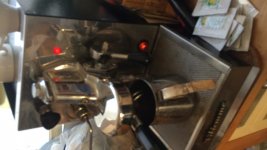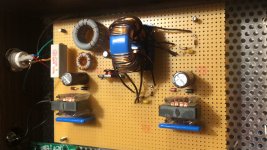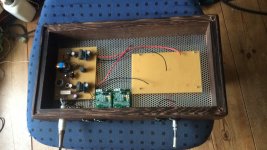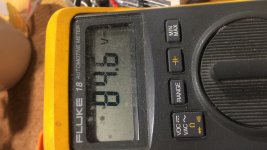The filter i use is not DIY (at this moment as i do not have the skills yet to create one myself in this quality). So i purchased one (Chord).
I use different NOS 16bit Dac's as i have 2 systems. One is balanced dual mono (2 mono SPDIF inputs) capable of handling 352,8kHz max sampling rates.
So i can use a filter that can upsample to this sampling rate. No additional bits as this i feel does not make any difference (correct me if i am wrong).
I think i have explained the dac's in detail somewhere. They are "floating" meaning no ground connection anywhere (like a phono cartridge).
This will improve the blacker then black quietness... and microdetail/microdynamics
I use different NOS 16bit Dac's as i have 2 systems. One is balanced dual mono (2 mono SPDIF inputs) capable of handling 352,8kHz max sampling rates.
So i can use a filter that can upsample to this sampling rate. No additional bits as this i feel does not make any difference (correct me if i am wrong).
I think i have explained the dac's in detail somewhere. They are "floating" meaning no ground connection anywhere (like a phono cartridge).
This will improve the blacker then black quietness... and microdetail/microdynamics
Another consideration is processor activity during the DA conversion, real time oversampling process in the DAC/filter chip, in some cases
maybe even source computer, could be a source of interference.
If it exists it could be avoided with pre-oversampled versions of the files.
maybe even source computer, could be a source of interference.
If it exists it could be avoided with pre-oversampled versions of the files.
I will not publish the ciruit here as i know that very soon after this an advert on ALI will offer this with a fancy description like:
"Golden Shimmering Sky Double Happiness Circuit"
"Golden Shimmering Sky Double Happiness Circuit"
Thanks Lampie - If you refer to HUGO M SCALER, I see the output is SPDIF. I passed this station long ago after using I2S directly and re clocking after a FIFO.
Would be nice nevertheless to connect one to my systems SPDIF input and compare
Would be nice nevertheless to connect one to my systems SPDIF input and compare
It could be safed as a file i guess, but why? It takes up more space (as do all the HQ files without any benefits).
Processing on a PC i can imagine but then again, how clean is your PC (noise free)?
Processing on a PC i can imagine but then again, how clean is your PC (noise free)?
Last edited:
"Would be nice nevertheless to connect one to my systems SPDIF input and compare"
You are invited ! I also have a nice Capuccino (no buffalo milk though).
You are invited ! I also have a nice Capuccino (no buffalo milk though).
Why? for the sake of this discussion.
It is not practical or something I would bother with in normal use, but it could be a consideration here.
About PC,
If you are running say an Rpi with minimal operating system, the oversampling processing could be quite a large source of activity relative to idle. Standard desktop running many processes with fans, HDDs etc. any difference in activity probably is already swamped.
It is not practical or something I would bother with in normal use, but it could be a consideration here.
About PC,
If you are running say an Rpi with minimal operating system, the oversampling processing could be quite a large source of activity relative to idle. Standard desktop running many processes with fans, HDDs etc. any difference in activity probably is already swamped.
Last edited:
I will not publish the ciruit here as i know that very soon after this an advert on ALI will offer this with a fancy description like:
"Golden Shimmering Sky Double Happiness Circuit"
So you have commercial ambitions? 🙂
//
I try to finance my hobby this way, so yes... maybe offering something as a kit could be an option. However it is kind of "fiddly" as it requires a lot of tuning (resonant circuits are involved). Until i have not yet figured out how to create a fool proof easy to copy design i will not offer any. I will get too many questions if it fails. Now on the other hand if i publish it then there could be some clever guys (as i am actually not very clever at all just pretending) out there who will solve this and run away with my idea, I hope you understand now a bit why i am hesitating. Also as i think i am on the right track i do not like to discuss my findings in any way. As stated earlier, you need to have at least heard it to be able to join a discussion in the first place.
Fancy a capuccino?
Fancy a capuccino?
Attachments
In other words NO more spline oversampling seen so far, as with today's R2R DAC may possible as 64x factor or more...
Back in the day, Wadia hired two PhD level engineers to do design work, although the idea for using spline filtering was thought up the the owner's son. The PhDs did lots of empirical research with layout, circuit tricks, and so on. People know about the spline filtering, so they tend to focus attention on that. All the other stuff that made Wadia dacs sound the way to did was not made public. How do I know? A friend worked there at the time and developed some of the circuitry.
That is indeed they way the entire digital (commercial) marketing machine works...
The moment the digital fiter was invented.... "now we have to develop better ones and more bits" etc. Just to have a new product instead of lookig at the real issues.
My point here (and opinion) if Philips had NOT added a FIR in its first 14bit players, we (Philips) would have no competition what so ever for a long long time !
Meaning: the entire CD Player market would have collapsed from the beginning (no need for any new products)
Some conspiracy theory .... who knows
The moment the digital fiter was invented.... "now we have to develop better ones and more bits" etc. Just to have a new product instead of lookig at the real issues.
My point here (and opinion) if Philips had NOT added a FIR in its first 14bit players, we (Philips) would have no competition what so ever for a long long time !
Meaning: the entire CD Player market would have collapsed from the beginning (no need for any new products)
Some conspiracy theory .... who knows
Last edited:
We diy'ers are "bad" customers anyway... only my electronics component supplier will disagree...
Don't tell my wife !
Don't tell my wife !
Last edited:
Most of the digital filter imperfections mentioned in this thread can be avoided using an FPGA for the filtering:
a) time-domain signal echoes produced within Equiripple on-chip FIR filters.
Can be made arbitrarily small (like < -120 dB) by designing for an extremely small passband ripple (like < +/- 0.00001737 dB for < -120 dB echoes according to Lagadec and Stockham's theory). You can even avoid passband ripples altogether by using Wilkinson filters or windowed sinc filters instead of Parks-McClellan filters.
b) impulse response ringing (pre or post)
Inevitable.
c) half-band filters plainly violating Nyquist
Can be avoided by choosing the start of the stopband at the Nyquist frequency and not above it.
d) are prone to clip on peak sample normalized recordings - the intersample overshoot issue.
Can be avoided by keeping some headroom (either fixed or user-selectable with a knob and a clipping lamp).
e) purely analog image-band suppression inherently sounds different than digital suppression?
Most analogue filters are minimum phase, you can also use a minimum-phase digital filter and take the lousy phase response for granted.
) non-linear effects due to rounding of intermediate results
By default, the Xilinx FIR compiler 5.0 uses full precision, so no rounding of intermediate results.
) non-linear effects due to rounding of the filter's output signal
Can be largely mitigated by using 2 LSB peak-peak triangular probability density function dither.
a) time-domain signal echoes produced within Equiripple on-chip FIR filters.
Can be made arbitrarily small (like < -120 dB) by designing for an extremely small passband ripple (like < +/- 0.00001737 dB for < -120 dB echoes according to Lagadec and Stockham's theory). You can even avoid passband ripples altogether by using Wilkinson filters or windowed sinc filters instead of Parks-McClellan filters.
b) impulse response ringing (pre or post)
Inevitable.
c) half-band filters plainly violating Nyquist
Can be avoided by choosing the start of the stopband at the Nyquist frequency and not above it.
d) are prone to clip on peak sample normalized recordings - the intersample overshoot issue.
Can be avoided by keeping some headroom (either fixed or user-selectable with a knob and a clipping lamp).
e) purely analog image-band suppression inherently sounds different than digital suppression?
Most analogue filters are minimum phase, you can also use a minimum-phase digital filter and take the lousy phase response for granted.
) non-linear effects due to rounding of intermediate results
By default, the Xilinx FIR compiler 5.0 uses full precision, so no rounding of intermediate results.
) non-linear effects due to rounding of the filter's output signal
Can be largely mitigated by using 2 LSB peak-peak triangular probability density function dither.
I whish i was smart enough to create a bespoke filter.... as the only programming language i understand is "soldering iron"
But with the tools (toys) i have at my disposal i can get there as well ;-)
But with the tools (toys) i have at my disposal i can get there as well ;-)
Last edited:
"c) half-band filters plainly violating Nyquist
Can be avoided by choosing the start of the stopband at the Nyquist frequency and not above it."
Or even before it 😉
//
Can be avoided by choosing the start of the stopband at the Nyquist frequency and not above it."
Or even before it 😉
//
That may actually be useful; when you make the transition band very narrow and let the stopband start at 0.45 fs, you probably filter off the aliases that the halfband filters used during recording didn't suppress properly.
Besides, there are Peter Craven's apodizing filters. You can reduce ringing of the whole recording-reproduction chain at the expense of treble by making one relatively smooth low-pass filter whose stopband starts at 0.45 fs, assuming that's still in the passbands of all other filters in the chain.
Besides, there are Peter Craven's apodizing filters. You can reduce ringing of the whole recording-reproduction chain at the expense of treble by making one relatively smooth low-pass filter whose stopband starts at 0.45 fs, assuming that's still in the passbands of all other filters in the chain.
Update after TNT's comment. For what it's worth, Lampie519 once informally listened to my apodizing filter and didn't like it much, at least not at 44.1 kHz sample rate. He preferred my steep filter which has its stopband starting at the Nyquist frequency.
Most of the digital filter imperfections mentioned in this thread can be avoided using an FPGA for the filtering:
a) time-domain signal echoes produced within Equiripple on-chip FIR filters.
Can be made arbitrarily small (like < -120 dB) by designing for an extremely small passband ripple (like < +/- 0.00001737 dB for < -120 dB echoes according to Lagadec and Stockham's theory). You can even avoid passband ripples altogether by using Wilkinson filters or windowed sinc filters instead of Parks-McClellan filters.
b) impulse response ringing (pre or post)
Inevitable and not an imperfection anyway, but a logical result of having a filter.
The ringing of the entire recording-reproduction chain can be reduced at the expense of treble by making an apodizing filter, a relatively smooth filter whose stopband starts at or just below the beginning of the transition band of the narrowest of the other filters in the chain (which would typically be 0.45 fs or 0.4535 fs).
c) half-band filters plainly violating Nyquist
Can be avoided by choosing the start of the stopband at (or below) the Nyquist frequency and not above it.
d) are prone to clip on peak sample normalized recordings - the intersample overshoot issue.
Can be avoided by keeping some headroom (either fixed or user-selectable with a knob and a clipping lamp).
e) purely analog image-band suppression inherently sounds different than digital suppression?
Most analogue filters are minimum phase, you can also use a minimum-phase digital filter and take the lousy phase response for granted.
) non-linear effects due to rounding of intermediate results
By default, the Xilinx FIR compiler 5.0 uses full precision, so no rounding of intermediate results.
) non-linear effects due to rounding of the filter's output signal
Can be largely mitigated by using 2 LSB peak-peak triangular probability density function dither.
Most of the digital filter imperfections mentioned in this thread can be avoided using an FPGA for the filtering:
a) time-domain signal echoes produced within Equiripple on-chip FIR filters.
Can be made arbitrarily small (like < -120 dB) by designing for an extremely small passband ripple (like < +/- 0.00001737 dB for < -120 dB echoes according to Lagadec and Stockham's theory). You can even avoid passband ripples altogether by using Wilkinson filters or windowed sinc filters instead of Parks-McClellan filters.
b) impulse response ringing (pre or post)
Inevitable and not an imperfection anyway, but a logical result of having a filter.
The ringing of the entire recording-reproduction chain can be reduced at the expense of treble by making an apodizing filter, a relatively smooth filter whose stopband starts at or just below the beginning of the transition band of the narrowest of the other filters in the chain (which would typically be 0.45 fs or 0.4535 fs).
c) half-band filters plainly violating Nyquist
Can be avoided by choosing the start of the stopband at (or below) the Nyquist frequency and not above it.
d) are prone to clip on peak sample normalized recordings - the intersample overshoot issue.
Can be avoided by keeping some headroom (either fixed or user-selectable with a knob and a clipping lamp).
e) purely analog image-band suppression inherently sounds different than digital suppression?
Most analogue filters are minimum phase, you can also use a minimum-phase digital filter and take the lousy phase response for granted.
) non-linear effects due to rounding of intermediate results
By default, the Xilinx FIR compiler 5.0 uses full precision, so no rounding of intermediate results.
) non-linear effects due to rounding of the filter's output signal
Can be largely mitigated by using 2 LSB peak-peak triangular probability density function dither.
Last edited:
- Home
- Source & Line
- Digital Line Level
- What do you think makes NOS sound different?



